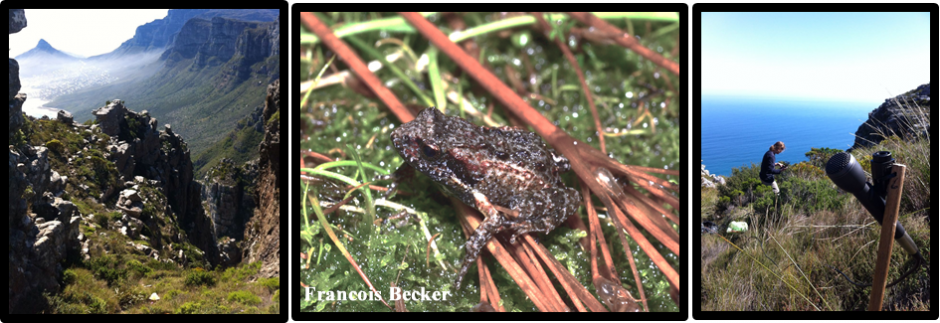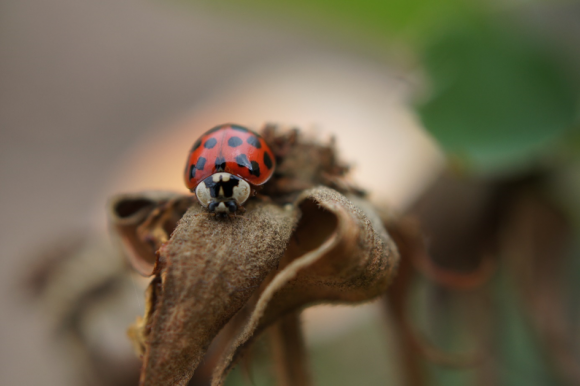7 April 2017 | By Marike Louw
“I love science and I love writing. I am just beginning to discover a world where the two can meet – one where science is not necessarily reserved for fellow scientists and where writing is not bound by the rigid laws of journal publications,” says C·I·B MSc student, Marike Louw, who was recently awarded the runner-up prize in this year’s Young Science Communicator’s Competition (YSCC).
The Young Science Communicator’s Competition (YSCC) is an annual competition that challenges young scientists and researchers between the ages of 18 and 35 to communicate their research to a larger audience beyond the scientific community. Marike’s popular article, titled “Listen up! Eaves-dropping on Cape Peninsula endemics” describes the difficulty that biologists have sampling tiny, shy frogs such as her study species, the Cape Peninsula Moss frogs (Arthroleptella lightfooti). Her popular article continues by introducing the use of a technique called Acoustic Spatial Capture-Recapture which can make sampling particularly tricky –but acoustically active- animals possible.
Below is an excerpt taken from Marike’s prize-winning article. To read Marike’s full article on the SAASTA’s website: Listen up! Eaves-dropping on Cape Peninsula endemics
Studying tiny, shy creatures
Until 2012, the Cape Peninsula Moss frogs had been calling away in their unquantified groups. We care about their numbers for many reasons. They exist only in the moist seepages on the mountains of the Cape Peninsula – nowhere else in the world will you hear their cheerful chirps. The metropolis of Cape Town surrounds them and continues to spread with time, isolating them even more dramatically. Changes in their population might indicate a change in the state of the fynbos, and can bring our attention to management practices that should be implemented in order to conserve this unique biome. Very little is known about their ecology and their functional role in the specific environment that they inhabit. Their tiny size (the largest individuals are a mere 22mm in length!) and visually elusive nature make it near impossible to study their populations with traditional population estimation methods.
The solution – Acoustic Spatial Capture Recapture
Acoustic Spatial Capture Recapture (aSCR) is a statistical technique that can be used to finally provide reliable density estimates of calling animals from recordings data from the field. Monitoring this species of frogs previously relied on experts listening and roughly quantifying the number of individuals calling. This is much easier said than done, because you can only imagine what it must be like to decide whether a large chorus of frogs consists of 10 or 100 individuals.
Gathering acoustic data for aSCR involves hiking to sites all over the Cape Peninsula and essentially eaves-dropping on the calling males. In my study, six microphones are placed in a rough circle in the midst of the calling frogs. These microphones are attached via cables to a single recorder which will record the entire soundscape in the vicinity – we call this setup an “acoustic array.” Back in the confines of civilization, the frog calls are isolated and analysed by being run through an Acoustic Spatial Capture-Recapture analysis programme, which looks at the information of the calls gathered across the six microphones and uses this to estimate the density of the calling animals.
Benefits of this technique
One of the greatest benefits of this technique is that it addresses a problem that often leaves scientists scratching their heads in indecision: deciding on the size of the area in which to count the number of individuals. This problem is addressed because each acoustic array determines its own “listening area” by taking into account that the chances of picking up frog calls decreases as the distance from each microphone increases. With aSCR, the irksome problem of deciding on the sampling area is solved.
“There is much more to learn with this powerful form of sampling in our hands. The frogs will start calling again in winter and we will be there to record them. Who knows what this year in the field will bring?” says Marike Louw.
For more information about her research, contact Marike Louw at marikelouw@sun.ac.za

Reaching recordings sites involves hiking up the mountains on the Cape peninsula (left). Cape Peninsula Moss frogs (Arthroleptella lightfooti) are small and visually cryptic (centre). An array consists of 6 microphones arranged around a recorder (right). (Photo credits: Francois Becker and Marike Louw)

